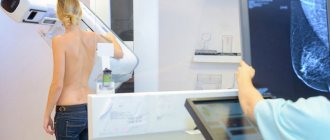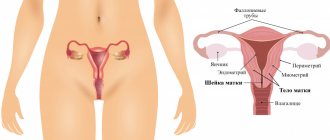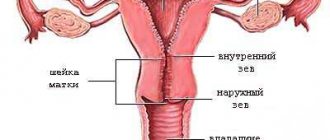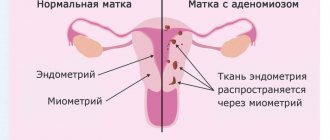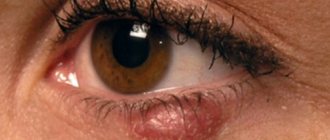Fibroids (fibroids) of the uterus are a benign tumor that is usually diagnosed in women between 35 and 46 years of age. Recently, there has been a trend toward “rejuvenation” of the disease, which is increasingly being found in young girls.
Until the neoplasm reaches an impressive size, beginning to put pressure on adjacent organs, fibroids can be asymptomatic. Malignancy of fibroids occurs in extremely rare cases.
Fibroma and uterine fibroids: what is the difference between pathologies?
Uterine fibroids begin their development in muscle tissue, while the formation of fibroids is caused by the proliferation of connective tissue. In addition, uterine fibroids have their own characteristics:
- Several clinical variants of uterine fibroids are known, differing in parameters, localization and growth characteristics of tumors;
- for a long time, the condition of small tumors may remain unchanged, however, some provoking factors can accelerate the growth of fibroids: abortions, diagnostic curettages, inflammatory diseases of the uterus and appendages;
- During menopause, a benign tumor of the uterus often stops growing, decreases in size or completely disappears. However, in 10-15% of women, the tumor may increase in size during the postmenopausal period.
Types, characteristics of fibroids
There are more than 10 different morphological variants. Pathologists give a description of what each form looks like and how it differs after histological examination - elastrophibroma, soft, dense fibroma.
- Dermatofibroma is a single or multiple formation of intradermal localization, mobile and painless when palpated with unchanged color.
- Desmoid fibroma has another name - aggressive fibrosis, refers to mesenchymal tumors originating from excess collagen fibers and differentiated fibroblasts. They often progress and recur, forming in soft tissues, the retroperitoneum or on the abdominal wall.
- Chondriomyxomas are rare tumors that affect bone tissue - the edges of long bones, pelvis, ribs, vertebrae, feet, metatarsus.
- Angiofibriomas in the cheek and nose area, containing small tubercles with connective tissue fibers.
Causes of uterine fibroids
The reasons for the development of uterine fibroids have not been reliably established to date. However, experts note a connection between the growth of this benign tumor and the level of estrogen in the female body. In addition, the occurrence of the disease can be triggered by the following negative factors:
- hereditary predisposition to the development of tumors in the uterus
- uncontrolled long-term hormonal contraception
- violation of the hormone-producing function of the ovaries
- long-term insolation
- absence of pregnancy and childbirth in a woman over 30 years of age
- hemodynamic disturbances in the pelvis
- inflammatory processes in the uterus and its appendages
- the presence of cysts in the ovaries
- abortions and diagnostic curettages.
Factors that contribute to the development of fibroids
Key reasons that lead to the occurrence of this pathology:
- Hormonal imbalance, which is a consequence of impaired ovarian function. This manifests itself in a significant decrease in the amount of progesterone in the blood serum or an increase in the concentration of estrogen.
- Irregular sex life, leading to stagnation of blood in the pulmonary circulation.
- Foci of infection in the pelvis that are in the chronic stage.
- Frequent manipulations and surgical interventions on the reproductive organs (abortion, curettage of the uterine cavity, insertion or removal of spirals into the uterine cavity, hysteroscopy, gynecological operations, difficult childbirth).
- Infertility, due to which a woman has given birth to only one child or has not given birth even once in her life.
- Endometriosis of the pelvic organs, or adenomyosis.
- Sedentary lifestyle.
- Genetic predisposition.
- Disorders during embryogenesis that led to the formation of fibroids in young women (under 30 years of age).
- Prolonged and frequent stressful situations that lead to hypofunction of the ovaries, thyroid gland and adrenal glands.
- Severe somatic pathology (arterial hypertension, increased body weight, diabetes mellitus).
- Poor nutrition.
- Decreased immune strength of the body.
Uterine fibroids: symptoms and signs
Small tumors do not manifest themselves for a long time. However, as they grow, characteristic signs of uterine fibroids appear. Typically, a benign uterine tumor is accompanied by the following symptoms:
- bleeding not related to the menstrual cycle
- painful sensations during menstruation
- prolongation of the period of menstrual flow
- frequent urination when the enlarged uterus compresses the bladder
- constipation due to compression of the intestines by the enlarged uterus
- a feeling of heaviness and pressure in the lower abdomen
- painful sensations during intimacy
- causeless growth of the abdomen
- pain in the lumbar region
- infertility
- neurological and mental disorders.
The severity of symptoms of uterine fibroids depends on the size, location of the neoplasm, and the intensity of its growth. In the early stages, a woman’s menstrual cycle may be disrupted, which should be the first “alarm bell” and a reason to consult a gynecologist.
More than 50% of women with uterine fibroids experience an increase in the volume of menstrual flow. This disorder causes the development of anemia, pathologies of the cardiovascular system, and blood coagulation disorders.
Pain due to uterine fibroids varies in nature - from pulling and aching to cramping.
With intraligamentary localization of the tumor, the ureters are compressed, as a result of which women experience urinary incontinence and other pathologies of the urinary process. When the intestines are compressed by a tumor, constipation may occur.
Due to abnormal changes in the liver in women suffering from fibroids, the hormonal balance is disrupted, and, consequently, the metabolism of fats, carbohydrates and proteins. In addition, there is a violation of thermoregulation, which leads to daily fluctuations in the patient’s temperature.
Clinical picture characteristic of fibroids
The main symptoms that are observed with fibroids:
- long and heavy menstruation with clots;
- intermenstrual bleeding from the uterus, leading to pathological weakness of the woman;
- symptoms of anemia, pasty lower extremities, increased heart rate or breathing;
- prolonged pain in the lower abdomen and lumbar region;
- difficulty in bowel movement;
- pain when urinating;
- an increase in abdominal volume without a general increase in body weight;
- dysfunction of adjacent organs due to compression by fibroids;
- pain during sexual intercourse against the background of intensive growth of myomatous nodes in the vaginal cavity;
- infertility and spontaneous abortion;
- hyperthermia due to torsion of the tumor stalk.
Uterine fibroid: diagnosis
Often, a doctor discovers uterine fibroids by chance during a gynecological examination regarding other complaints of the patient. The presence of a benign tumor can initially be suspected by an increase in the size of the uterus.
To clarify the location of the tumor and the number of nodes, the woman is prescribed additional diagnostic studies:
- clinical laboratory studies and pregnancy tests
- ultrasound examination of the pelvic organs - to identify pathological processes in the uterus
- hysteroscopy - an instrumental examination, for which a special apparatus (hysteroscope) and an optical instrument are used. Prescribed to clarify the features of the hyperplastic process in the uterus, identify suspicious areas of the endometrium and perform a biopsy
- laparoscopy – prescribed according to indications, allows you to examine the uterine cavity using an endoscope
- Metrosalpingography is a contrast X-ray examination that allows you to assess the condition of the uterine cavity and the patency of the fallopian tubes.
Why does fibroid develop?
The reasons for the formation of nodes are perhaps obvious; they are also the causes of many gynecological diseases and conditions (dysmenorrhea, endometriosis, early menopause and others):
- Disruption of hormone production for various reasons: chronic stress, exhausting physical work, taking certain hormonal drugs, endocrine diseases; the predominance of estrogen production over progesterone production leads to the growth of the muscular layer of the uterus;
- Late labor, more than 5 births;
- Infections of the genital organs;
- Chronic inflammatory processes of the uterus and its appendages;
- Hereditary predisposition;
- Habitual miscarriage.
Uterine fibroid: treatment
When choosing treatment tactics, doctors are based on the results of the examination, taking into account the location of the fibroids, the size of the node and the need to preserve the reproductive function of the patient diagnosed with uterine fibroids. Treatment can be carried out conservatively or surgically.
Uterine fibroid: conservative treatment
Conservative therapy for uterine fibroids involves the use of hormonal drugs to help stop tumor growth. This type of treatment is indicated for the following conditions:
- small size node (less than 12 weeks of pregnancy)
- mild symptoms that do not reduce the patient’s quality of life
- the need to preserve a woman’s reproductive function
- extragenital diseases that are a contraindication to surgical treatment
- postoperative rehabilitation or preparation for myomectomy.
The positive effect of hormonal therapy is achieved if it is continued for at least six months. This or that drug is selected in accordance with the patient’s age and the characteristics of the course of the disease. Hormone therapy for uterine fibroids is carried out using the following drugs:
- estrogen-progestin drugs
- progestational drugs
- androgen drugs
- GnRH and antigonadotropic drugs.
Hormonal therapy for uterine fibroids has a number of contraindications:
- intense increase in tumor size
- presence of severe pain, frequent bleeding
- size of the uterus exceeding 12 weeks of pregnancy
- concomitant diseases of the pelvic organs
- somatic pathologies (not used in the presence of diabetes mellitus, hypercoagulation, hypertension, etc.).
In addition to hormonal therapy, nonspecific methods that affect the elements of the pathogenesis of the disease are used to treat uterine fibroids:
- vitamin therapy - taking vitamin and mineral complexes to speed up metabolic processes in the body and improve the general condition of a woman;
- diet therapy – the patient’s diet includes iron-containing and protein foods, as well as foods that help improve liver function;
- immunomodulatory therapy - to strengthen the immune system;
- antianemic therapy – for large blood losses during menstruation;
- taking sedative drugs – prescribed for vegetative-vascular pathologies;
- venotonics – normalizing the menstrual cycle;
- physiotherapeutic treatment – magnetic therapy, autotransfusion, electrophoresis, etc.
In the absence of an increase in symptoms and an increase in the size of fibroids, the woman is prescribed dynamic observation by a doctor with regular ultrasound examinations, which allows assessing the condition of the tumor.
Before making a decision
Since fibroids are not cancerous and develop quite slowly, you have time to gather the necessary information about which treatment method to choose and whether treatment is worth it at all. The option that is right for you depends on many factors, depending on how severe the symptoms are, whether you plan to have children in the future, how long it will take to reach menopause, and whether you want to have surgery.
Before making a decision, consider all the pros and cons of possible treatment options, taking into account the individual characteristics of the body. Remember that most women with fibroids do not need treatment.
Surgical treatment of fibroids
Patients with uterine fibroids undergo radical and conservative operations. Each of these methods has indications and contraindications. Complete removal of the uterus is motivated by the high frequency of concomitant diseases of the uterus:
- hyperplastic processes of the endometrium,
- pathological changes in the cervix,
- malignant processes in the endometrium,
- the occurrence of sarcomatous growth in the myomatous node.
These changes occur more often in older women. Operations can be carried out:
- abdominal or vaginal route,
- laparoscopically
- laparotomy.
This depends on a number of factors:
- tumor size,
- the need for an abdominal examination,
- severe obesity of the anterior abdominal wall,
- the need to carry out additional intervention on the ovaries, fallopian tubes, etc.
The issue of removing the ovaries during surgery is decided individually in each case. During conservative myomectomy in young women, if there are cystic changes in the ovaries, wedge resection is indicated, but if there is a concomitant ovarian tumor, tumor removal is indicated. In postmenopausal women, if there are pathological changes in the ovaries, they should be removed.
When performing conservative plastic surgery on the uterus, the fallopian tubes should be preserved. If necessary, plastic surgery is also performed on the fallopian tube to restore its patency simultaneously with conservative myomectomy.
In case of supravaginal amputation of the uterus or its extirpation, the issue of leaving or removing the fallopian tubes is decided individually in each case. If uterine fibroids are accompanied by an inflammatory process in the pelvis, the fallopian tubes should be removed, as they can be a source of infection in the postoperative period. For the same reasons, it is necessary to remove the fallopian tubes in case of necrotic changes and purulent melting of uterine fibroid nodes. If there is an uncomplicated uterine fibroid, but the fallopian tubes are stretched on the tumor nodes, then they should not be preserved either. The fallopian tubes are also removed if there are inflammatory changes in them, since pyosalpinx may occur in the postoperative period, which will require relaparotomy in the future. In all other cases, the fallopian tubes must be preserved, since their removal to some extent disrupts the innervation and blood supply of the ovaries and leads to a more rapid decline of their function.
Emergency and planned removal of fibroids
Surgeries for uterine fibroids are performed emergency and planned. Emergency indications arise in case of bleeding associated with a danger to the patient’s life, torsion of the leg of the myomatous node, necrosis or suppuration of the myomatous node. In all these cases, urgent surgery is indicated. The only contraindication to surgery is the agonal state of the patient.
Scope of operation
When deciding on the volume of the operation, i.e. amputation of the uterus or its extirpation, one should be guided by the condition of the cervix. If no pathological changes are detected, then supravaginal amputation of the uterus is performed. An unchanged cervix should not be removed. Currently, the latest technical means are used during the operation: lasers (carbon dioxide, argon), special ultrasonic scalpels, etc. After laparoscopy, only small “dots” of 0.5-1 cm are noticeable, since only 5 mm punctures are made for insertion into the belly of the instruments. The length of stay in the hospital is reduced to 4-5 days, and immediately after discharge the woman is able to work. Recently, the technique of uterine artery embolization has been actively introduced into gynecological surgical practice, making it possible to reduce, sometimes to a minimum, the size of fibroids and avoid removal of the uterus. If it is possible to perform the operation through vaginal access or using a hysteroscope, there are no external traces of the surgical intervention left at all. Apart from the woman herself and the gynecologist, no one will ever know what kind of operation she underwent.
